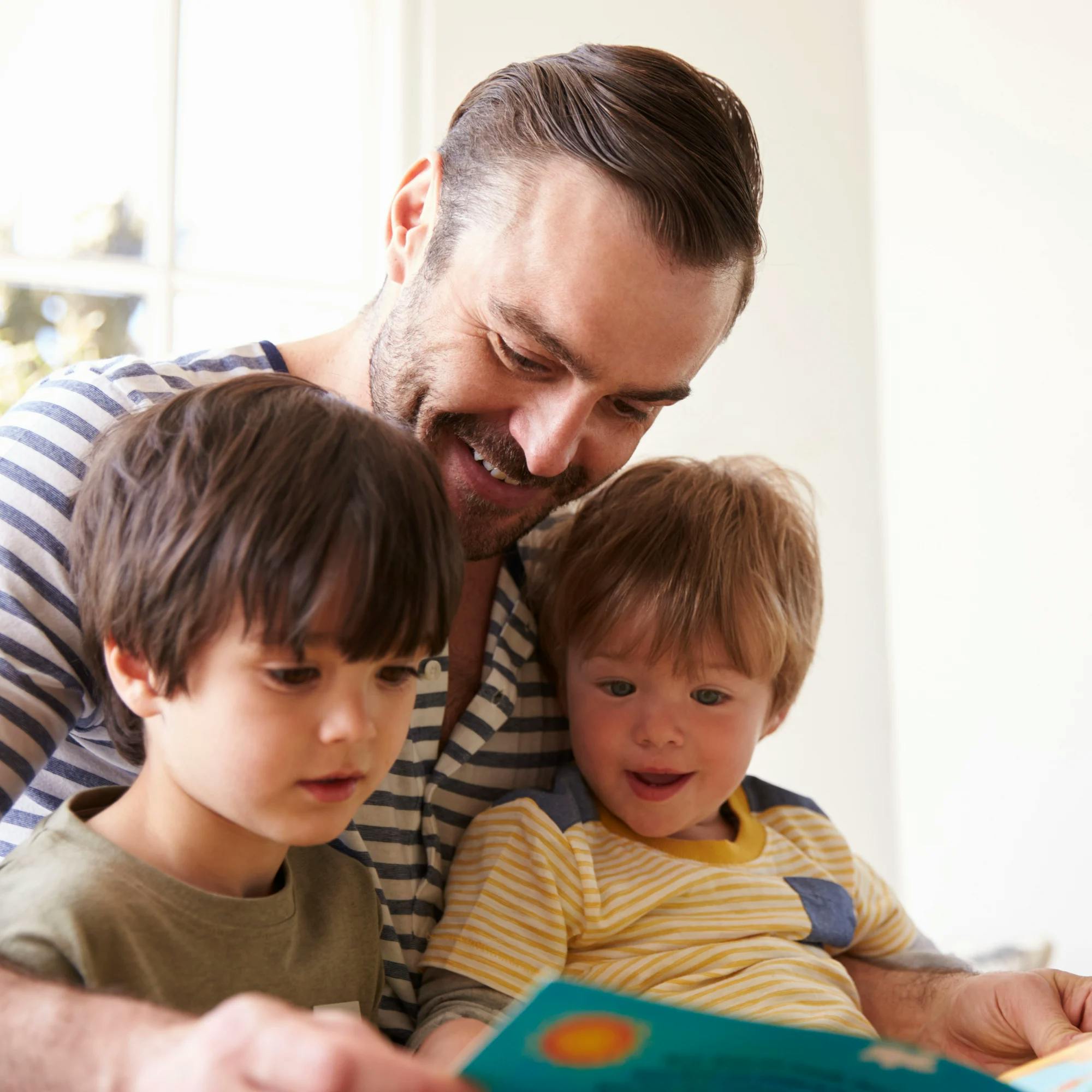Whether you’re helping your toddler learn to talk or working on comprehension skills with your third grader, books are an easy (and fun!) way to work on language development.
You’re probably aware of how important it is to read with your child. One reason is that reading together helps build your child’s communication skills. Children of all ages learn our language by listening to others. And what’s a better way to do that than by cuddling up with a book?
While most any book can help with speech and language development, this list from our speech therapists highlights recommended books that work well to target communication growth. We’ve also provided easy techniques and activities to use with each book. While some of these books are ideal for very early language learners, others are perfect for kids working on more advanced skills. There’s something here for everyone!
Tip: Check out this Instagram post from one of our speech therapists to learn how to adapt children’s books to any age! This can be helpful for reading the same book to siblings of different ages, or continuing to read a favorite book with your child as they get older. You can even adapt a book for older kiddos to enjoy it with your toddler!
First, what speech and language skills can you practice with books?
Whether you have an 8-month-old or an 8-year-old, there are so many ways to use books to strengthen their communication skills. In the list below, we discuss how reading together can help with:
Identifying pictures
Imitating gestures
Imitating sounds and words
Filling in the blanks
Labeling items
Answering questions
Speaking in longer phrases and sentences
Problem-solving skills
Retelling skills
And if your child is working on speech sounds, you can practice with almost any book! As an example, if your kiddo is working on the /s/ sound or the /r/ sound, you can pause and repeat words that contain these sounds as they come up in the book. Depending on your child’s skill level, they can practice saying the word by itself or using it in a sentence.
And now, on to the books!


First 100 Words
For infants and early talkers, books with photos of everyday items or animals are perfect. The images help babies learn the names of things they often see and use.
When it’s time to read, sit face to face with your baby. This way they can see the book and watch your mouth and how you form each word and sound.
First 100 Words is always a crowd pleaser. As you read, name the items you see on the page. Be sure to spend time on each picture.
For example, if there is a picture of milk, say the word a couple times as you point to it: “Milk, milk.” You can also emphasize the beginning sound, “Mmmmmilk.” Pointing to your mouth when emphasizing sounds or teaching new words is helpful for babies and early talkers.
Pointing to your mouth when emphasizing sounds or teaching new words is helpful for babies and early talkers.
To mix it up and teach even more vocabulary, use the target words in sentences. Maybe something like, “You drink milk,” or “The milk is in a cup.”
If you want to target receptive language, which refers to how your child understands words and language, you can ask your child to point to different pictures. You can say, “Show me the dog,” or “Point to the car.” When toddlers are first learning language, they’ll likely need some help. You can gently move their hand to the picture you’re asking about to help them learn this new vocabulary.
These tasks may seem structured, but it’s also fine to go with the flow! Your child may be interested in a different picture than the one you asked them about. Or maybe they’re ready to turn the page. That’s OK! You can shift your focus to what’s motivating them in that moment.


Brown Bear, Brown Bear, What Do You See?
Who doesn’t love a classic Eric Carle book? Brown Bear, Brown Bear has been beloved by families for decades. Let’s review some new ways to use this old favorite with your child.
One of the key benefits of this book when it comes to speech and language is its repetitiveness. The famous line “Brown bear, brown bear, what do you see? I see a ______ looking at me” becomes easy for kids to remember when they hear it over and over on each page.
With this book, you can use fill-in-the-blank activities. That means pausing to have your child try to fill in the rest of the phrase. So you may say, “Brown bear, brown bear…” and wait for your child to finish the rest.
If your child isn't saying phrases independently yet, you can try having them imitate a phrase after you. It can be something as simple as a two-word phrase: “I see.” This book provides plenty of opportunities for your child to practice their phrases over and over.
Labeling is also a great target with this book. There’s a new animal on each page that your toddler can practice naming. Feel free to help them as needed, of course.


Poke-a-Dot books
If you haven’t seen these Poke-a-Dot books, you’re going to want to grab one ASAP! Young children love these books. Each page features several plastic dots the child can push. Every time they push one, it makes a “pop!” sound.
Modeling how to pop each dot and having your child repeat after you is perfect for practicing gesture imitation. Gesture imitation is a stepping stone to word imitation. So start popping those dots together–your child will be having a blast and learning new skills!
To practice verbalizations, have your child label items on the page or say something about what they see. You can reward them with getting to pop the dot on the page after each verbalization. These books are great for little ones that need extra motivation!


From Head to Toe
Another Eric Carle book you may be familiar with is From Head to Toe. This book works well for practicing gesture imitation. The book shows different animals that say they can do different actions, such as turning their head or clapping their hands. The child in the book then does the action–and your child can, too! Not only will they learn to imitate gestures, they’ll also begin to learn the names of these actions.
Learning action words also helps children start learning how to form phrases. For example, if they learn the word “eat,” they can start saying things such as, “I eat!” to let you know they’re hungry.
Being able to express wants and needs is a skill that doesn’t just show up over time. Skills like these need to be practiced over and over. And it all starts with simple tasks you do together, like reading!


If You Give a Mouse a Cookie
If You Give a Mouse a Cookie has plenty of opportunities for language learning. Similar to Brown Bear, Brown Bear, this book repeats several phrases over and over. This allows for imitating phrases or sentences and filling in the blank.
For older kids, you can work on answering questions. You can ask things such as, “Why does the mouse need the tape?” or “Where did the mouse find the milk?” The ability to answer questions is a key skill in language development. Practicing with books is a natural way to work on this goal together.
Here’s something else you can try. As your child answers the questions, you can target appropriate sentence structure. When they answer the question, have them use complete sentences, not leaving any words out.


How to Catch books
The How to Catch books by Adam Wallace are a hit with many older kids. In them, a group of kids sets out to find different things, like a yeti, a mermaid, a dinosaur…the list goes on and on! They set silly traps to try to catch what they’re looking for.
As you read the book, you and your child can practice identifying a problem and a solution in the story. Talk through the situation and prompt them to answer as needed. Problem-solving, and verbally talking through a problem, is something children should be able to do as they get older and gain more language abilities.
Inferencing is another higher level skill for kids. When your child is around 4 or 5 years old, start practicing inferring with them. For example, you can ask what they think will happen next in the story, or how they think a character is feeling.
The Bad Seed
The Bad Seed by Jory John is an excellent option for school-age kids. It’s a heartwarming story with some good life lessons, and it’s a great book to elicit language skills in older children.
Specifically, you can work on socioemotional learning, such as understanding and expressing feelings. There are many opportunities to discuss feelings and emotions throughout the book.
After reading the story, ask your child some comprehension questions to see how well they understood specific details. To target story retelling, ask your child to tell you what happened in the book. Look for at least a beginning, middle, and end in their retelling.


Jabari Jumps
Another great book for socioemotional learning is Jabari Jumps by Gaia Cornwall. In this story, a little boy is learning to jump off the diving board. First, he has to learn to overcome his fears. This is a wonderful book to read with your school-age child to practice inferring the character’s feelings. You can also ask your child about different situations they experience in their own life and how they feel about them. The ability to name emotions is an important skill for all kids.


The Couch Potato
The Couch Potato, also by Jory John, is a fun choice for school-age kids. This book focuses on a character that has to get outside, away from screens. With this story, kids can practice verbally predicting what will happen next. It’s also a great opportunity for you to get their opinions on screentime. A healthy debate is sure to strengthen those expressive language skills!
The social and bonding aspects of reading with your child
No matter what book you read with your child, you are growing and encouraging their social skills and social language development. Reading together gives you and your child a chance to talk, connect, and even share a laugh. These social routines encourage good social development in all stages of childhood. And it’s a priceless bonding opportunity for both of you.

 Abby Barnes, M.S., CCC-SLP
Abby Barnes, M.S., CCC-SLP











